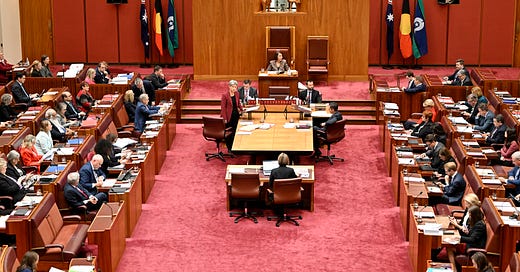
The party that can command 76 votes in the House of Representatives is the one that forms government. If it does not have enough votes of its own, it can enlist the support of minor parties and independents. This is known as minority government.
Many political commentators believe Labor will not have 76 votes after this election but will require the support of minor parties and independents to retain government.
That may be the case, but it is not the full story. To implement its program, a government needs its bills to be passed by the Senate. There, the numbers are quite different. In the 40 years since the Senate was enlarged to 76 senators, neither major party has had a majority except between 2004 and 2007 when the Howard government had 39 senators. The rest of the time the votes of minor parties and independents have determined the outcomes.
After the 2022 election Labor held just 25 votes in the Senate, which became 24 when Fatima Payman defected. Nonetheless, it has been able to pass legislation with the support of the 11 Greens, Greens defector Lidia Thorpe, pale green David Pocock, Payman and, quite often, Jaqui Lambie and her former colleague Tammy Tyrell.
Despite having 30 seats, the Coalition has only been able to rely on the support of One Nation’s two votes (Pauline Hanson and Malcolm Roberts), the UAP’s Ralph Babet, and former Liberals Rennick and Van. In practical terms it has been close to toothless.
Being in government but unable to pass legislation due to a lack of numbers in the Senate is not something the Coalition should welcome.
The opinion polls suggest a major swing is unlikely, which means the composition of the Senate after the election is relatively predictable. No matter who wins the most votes in the House of Representatives and forms government, and irrespective of whether it is a minority government, neither major party will have a majority in the Senate.
The Senate is comprised of 12 senators elected from each of the six states, plus two each from the Australian Capital Territory and the Northern Territory. The ACT and NT senators are elected every election, while the senators representing the states serve for two terms of government, meaning that only six are up for election.
In the ACT and NT, one seat is typically held by Labor and the other by the Coalition. However, in 2022 David Pocock defeated the Liberals in the ACT. Given Canberra’s left-wing inclinations, most think the Liberals will struggle to regain it. So, no change is likely there.
In the states it is often the case that two seats are won by Labor, two by the Coalition, one Green, with the final seat taken by a minor party.
This will probably remain true in Tasmania, where the sitting minor party candidate is Jacqui Lambie. For reasons best known to Tasmanians, she seems likely to be re-elected.
It has also mostly been true in Victoria, although the current sitting independent, David Van, is a former Liberal. Minor parties have traditionally done well in Victoria and a host of them are vying to take his seat.
In NSW, SA and WA, the Coalition has three positions up for election. Labor is very likely to hold its two seats, and the Greens their seat, so a win by a minor party would be at the expense of the Coalition.
The most interesting state is Queensland, where Labor only has one seat at stake. Given its history and polling, it stands a good chance of picking up a second seat. The contest for the fifth and sixth seats will be between the Greens (which are less popular than in other states), One Nation’s Malcolm Roberts, former LNP senator Gerard Rennick, plus several minor parties.
The opinion polls suggest a major swing is unlikely, which means the composition of the Senate after the election is relatively predictable.
The bottom line is that there is a high chance Labor will gain an additional senator, while the Coalition has four seats at risk and seems likely to lose at least one of them.
Labor will probably finish with 25 senators. In most cases it will be able to count on the votes of the Greens (with 11 or 12 seats) plus Pocock, Thorpe and Payman, ensuring it has a majority.
If the Coalition wins government, the Senate numbers will be much the same. There is no realistic way it could achieve a majority of 39 votes with the support of the non-left minor parties. Indeed, it would be in a worse situation than the Abbott government after the 2013 election, which negotiated the support of most of the crossbench to repeal the carbon and mining taxes and stop the boats, but was then unable to pass its budget measures.
Being in government but unable to pass legislation due to a lack of numbers in the Senate is not something the Coalition should welcome. Indeed, it is arguably worse than being in opposition; at least it doesn’t look weak and impotent.
Some are suggesting it wouldn’t be altogether bad if the Coalition lost this election and allowed Labor to make a mess of minority government.
But that would only make sense if it used the time to adopt a vote winning strategy, including a policy of promoting friendly minor parties in the Senate which could win if the Liberals cannot.











